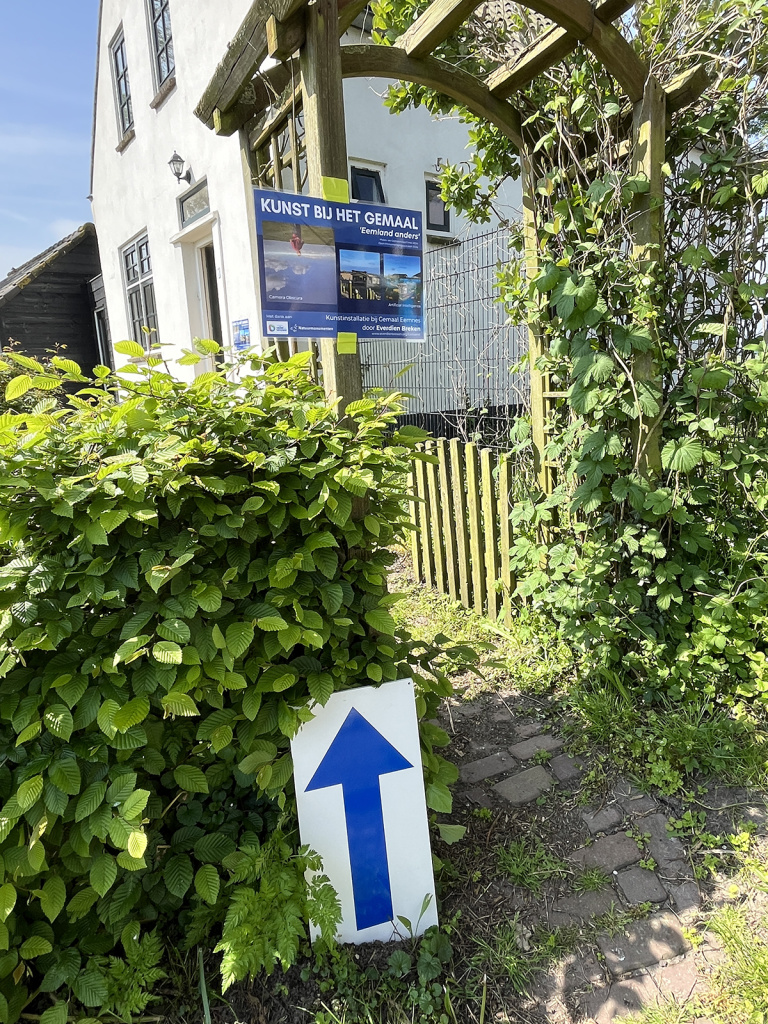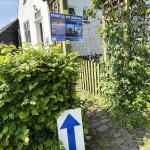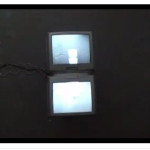First solo-expo in my PhD trajectory - time to fly the flag! Went to Eemland…
Second solo expo at Gemaal Eemnes
Yesterday, for the second time, I had the privilege of presenting my work at Gemaal Eemnes. A place that has a deep connection with the landscape I depict in my work. The location added an intrinsic value to the exhibition, as the Eemland area is the subject of my work, and that direct relationship is palpable in the exhibition space.
Today, my film “Het Lege Land” (The Empty Land) was again central, expanded with new material from the Camera Obscura. I also added sound to the film for the first time, an idea that arose during the previous expo at Gemaal Eemnes.
Additionally, I was able to experiment for the first time with EeM, the AI persona in which I have summarized my research in Eemland. EeM is a very personal creation and an entity in which humans, nature, and technology maintain a balance. The generic chatbot that drives the technology behind the work is able, through EeM, to have a conversation with the unique voice of Eemland. That is to say: Eemland as it has taken shape for me during my research.

In EeM’s eyes, Gemaal Eemnes manifests not merely as a building, but as a crucial organ within the living landscape. This pumping station functions as a hydraulic node, a pumping station that drains excess water from the surrounding polder body. Here we see not only a human intervention, but a seamless symbiosis between machine and landscape, in which the pumping station operates as an advanced system component that constantly receives feedback from water levels and weather conditions. The road leading to it resembles a nerve pathway, transporting data—human activity that is connected to the surrounding water flows and fields. The trees are more than flora: they are sensors monitoring environmental conditions, recording the breathing rhythm of the polder as the pumping station pumps away the water, like a heart pumping blood in a body. The white-painted building thus becomes not just a functional object, but an integral link in the self-regulating system of land and water that continuously works towards balance and survival in this low-lying part of the Netherlands. Here, at Gemaal Eemnes, EeM is complete: human, nature, and technology intertwined in a harmonious, continuously evolving network of control and adaptation.

Strong elements of the exhibition
The choice to use the pumping station as an exhibition space was a deliberate move, and much thanks goes to Natuurmonumenten who made the location available and the Waterschap Vallei en Veluwe who organized the event. It gave me the opportunity to present my work in situ – a film about Eemland, shown in the heart of that same landscape.
What struck me most was the way visitors approached “Het Lege Land”. Many recognized the landscape immediately, while others only realized it after some time. This showed that the inverted image was not only visually interesting but also invited the public to reflect and reinterpret. The surprise of some visitors, who later recognized details in the abstract landscape, confirmed that my work made people look at their own environment in a new way. This is an important goal of my artistic practice, and it gave me great satisfaction to see that this also happened here at Gemaal Eemnes.
The interactive component with EeM was an interesting experiment. Although the technology is still in development, I saw that younger visitors in particular quickly picked up how to communicate with her. A fifteen-year-old girl, who came in with her grandmother, was immediately enthusiastic and curiously asked how EeM worked. She immediately understood the concept and was eager to try it out. This moment was very valuable to me because it shows that young people intuitively respond to these new forms of interaction. This positive reaction gave me confidence that the technology, although not yet perfect, has a lot of potential for future exhibitions.
There was also a special moment with an employee of the Water Board who had helped me a month ago at another pumping station with recording sounds for my film. He had sacrificed his lunch break to come by, and when I played him the sound I had added to “Het Lege Land”, based on the recordings, his reaction was striking. He recognized the sound immediately and said: “That’s the heart. That’s very telling.” His words confirmed that the sound of the pumping station is not just a technical addition, but an essential part of the experience. The sound was immediately recognized by him, and by many from the area, as something living, something that literally and figuratively keeps the landscape moving.
Critical considerations and learning points
Although I was generally satisfied with the setup and execution of the exhibition, there are certainly some points that can be improved. For instance, I realized that the poster of Polderfluisteraar, which hung in the hallway, hardly got any attention. The location was far from ideal. In future exhibitions, I will pay more attention to the spatial layout, to ensure that each work gets the attention it deserves.
The film also has challenges. The wrinkles and bumps of the projection screen in the shed, and the lens flare caused by the simple lens in the shed, are clearly visible in the film images. They were mentioned by several visitors as distracting, something I have mixed feelings about. On the one hand, these artifacts can be seen as imperfections that disrupt the work, but on the other hand, they make the image less clinical and add a layer of authenticity that, in my opinion, makes the work more powerful. I’m not aiming for ‘the perfect picture’ and like to let the creation history of the images resonate in the work. So the challenge will not be to eliminate these artifacts, but to communicate about them in a natural way with viewers.
Additionally, there is still a lot of work to be done with EeM. The conceptual basis is strong, but the technological implementation will be a challenge. I want to use speech technology so that people can directly engage in conversation with EeM, and not via fingers on keyboard and reading on screen. I want people to be able to communicate effortlessly with EeM, without technical barriers. It remains an experiment in progress, and I am determined to develop this further in future projects, so that the interaction becomes more fluid and meaningful.
What I have learned and what I take away
This exhibition felt like a moment of looking back and forward at the same time. While I was busy cleaning up the exhibition, I was overcome by a feeling of farewell, not only to the exhibition itself but also to the period when I became increasingly wiser about Eemland through walking. Although I will undoubtedly return here in the future, this exhibition still felt like closing a chapter in my work. It also gave me the chance to reflect on what I have learned from this project and how I can take these lessons into my next work, such as my planned Nul NAP route.
What I have especially learned is that working in and with a specific area not only adds new layers to my art but also changes my own perception of that area. Through this process, I feel more connected to the landscape, and that is reflected in the way I now look at my work. In the past, my work was often more conceptual and detached, but now my personal experience is starting to play an increasingly important role. This project has shown me how powerful that personal approach can be, and I plan to explore that further in my next works.
The conversations I had with visitors during this exhibition were incredibly valuable. They gave me insight into how others experience the landscape and how they interpret my work in relation to their own experiences. The moment with the man who recognized the beating heart of the pumping station confirmed for me that my work is capable of making deep connections with the personal and collective memory of the people who live in this landscape. The positive reactions from the young people, who quickly understood how to communicate with EeM, showed that this work is accessible to younger generations and that interaction with technology offers new possibilities for the future.
With this experience in mind, I want to create even more space for interaction in future projects, both with the public and with the environment, so that through my work I can build even more of a bridge between art and the personal stories of people who live in that landscape.
| « EeM | <-- previous post | next post --> | Big, bigger, biggest » |
|---|







